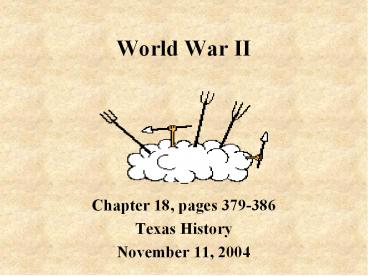World War II - PowerPoint PPT Presentation
Title: World War II
1
World War II
- Chapter 18, pages 379-386
- Texas History
- November 11, 2004
2
I. Introduction
- Dec. 7, 1941-Japanese attack on Pearl Harbor
vaults U.S. into the war. - Texas people and govt. support war
- Industrial production soars
- New military bases dot the landscape
- Farmers still not sharing in the profits
3
II. The Politics of Wartime
- War called for rationing program
- Stevenson (governor) rigid economy, no striking
by unions - State agencies regulated rationing and
productions - Texans grew victory gardens bought savings
bonds, practiced blackouts, air raids - State set up spending could not exceed income
4
III. Texas and Texans in the War
- 15 training posts, 21 prisoner of war camps
- San Antonio- Ft. Sam Houston, Randolph, Kelly and
Brooks Field - 750,000 Texans served during the war, 23, 000
die - Chester Nimitz- head of war in Pacific, Dwight
Eisenhower- Supreme Commander in Europe - Audie Murphy- most decorated soldier
- Minorities serve- blacks in segregated units
5
- Blacks faced many forms of discrimination
- Some bases didnt want blacks assigned
- Race riots occurred in different places
- Growing demands for equality- white primaries
declared unconstitutional - Better funding for black schools and teachers
- Mexican Americans- also faced problems
- Limited workers from Mexico
- Some communities restricted ability to move in
- LULAC helped motivate political participation
- Voter registration
6
IV. Causes of the War
- Extreme nationalism of Germany, Italy, and Japan
- The rise of Adolph Hitler and the failure of
other nations to stop his territorial designs - Failure of the Treaty of Versailles- (WWI) harsh
treatment of Germany- 1920s - Rearmament of Germany while others fell behind-
1930s - American neutrality left allies to handle
situation
7
(No Transcript)
8
V. European Theater
- War begins Sept. 1, 1939- Germany invades Poland
- 1940- Germany sweeps across France and other
countries- looks unbeatable - June 22, 1941- Invasion of Soviet Union- Hitlers
biggest mistake - Dec. 1941- U. S. enters war-
- Nov. 1941- invasion of N. Africa
- June 6, 1944- invasion of France
- May 1945- Germany surrenders
9
VI. Pacific Theater
- Japan invades Manchuria, 1931
- U. S. attempts to control Japan with economic
sanctions - Dec. 7, 1941- Pearl Harbor Attacked
- June 1942- Midway
- Nov. 1942- Guadalcanal
- June 1944- Philippines
- 1945- attacks on Japanese islands of Okinawa and
Iwo Jima - August 6 and 9, 1945- Hiroshima and Nagasaki-
ends war
10
VII. Results
- Maybe as many as 80 million dead
- Germany and Japan are destroyed, many parts of
Europe and China are in ruins - Soviet Union rises to power to rival U.S.
- Cold War begins- threat of nuclear war
- Soviet takeover of Eastern Europe and parts of
Asia - 6 million Jews exterminated in death camps
- Use of atomic bomb ushers in the nuclear age
11
And After, 1945-1962
- Chapter 18 Notes, pages 386-399
- Texas History
12
Postwar YearsThe Jester Years, 1947-1949
- A. opposed to new taxes, economy was strong
enough to pay for higher expenditures - B. right to work law- worker who works in a
union shop does not have to join - C. election for U.S. Senate catches attention-
LBJ wins by only 87 votes- probable fraud in
election - D. state schools reorganized in 1949- 12th year
added, more vocational classes, funding still
problem
13
II. Shivers, Politics and Tidelands
- A. Shivers becomes governor after Jesters death
- B. helped funding for state hospitals
- C. Taxes increased during 1950s, redrew
congressional voting lines, car safety - D. national issues becoming important
- E. election of 1952- Texans vote for Eisenhower,
Rep. party reborn
14
III. Scandals and Reform, Politics in the 1950s
- A. decade of scares and struggles- Red scare,
minorities fighting for equality - B. Cold War made many people suspicious of the
actions of others, books banned, loyalty oaths,
dismissal of people who were thought to be
Communist - C. Black began to get rights- Brown v. School
Board of Topeka, Kansas- outlawed separate but
equal - D. Fight for equality has victories and defeats
15
- E. Mexican Americans- progress made, still some
barriers - F. Henry B. Gonzales- elected to state senate-
1956 - G. Democratic Party splits between conservatives
and liberals - H. Legislative scandal- state legislators linked
to industry and big business
16
IV. The election of 1960 and the emerging
Republican Party
- A. Johnson ran for Senate and VP, Kennedy wins
election - B. John Tower, R. wins race for Johnsons seat
- C. Republican party will gather strength in the
60s































